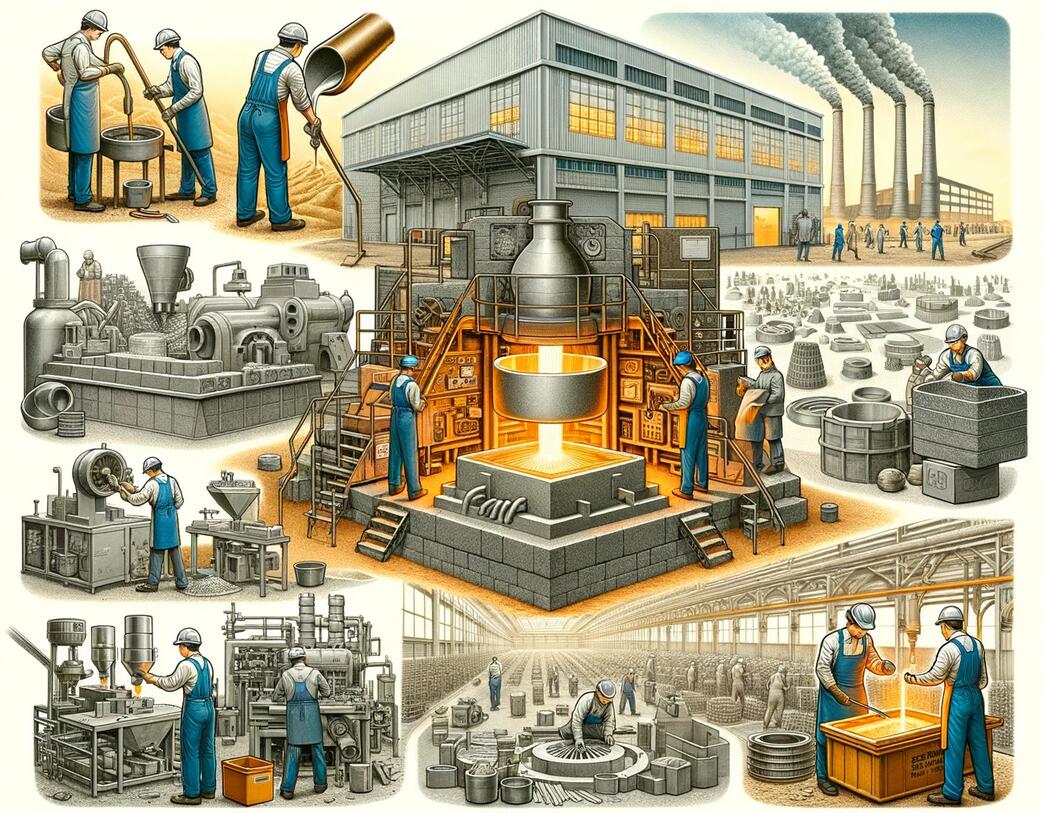Exploring the Depths of Sand Casting: Innovative Techniques and Products
Introduction
Sand casting, an ancient yet perpetually relevant manufacturing technique, is pivotal in the modern industrial landscape. This article delves into the depths of sand casting, exploring its fundamental principles, varied applications, and the meticulous process that transforms simple sand into complex and valuable products.
Understanding Sand Casting
Definition and History
Sand casting, dating back thousands of years, involves forming metal objects by pouring molten metal into a sand mold. This technique has evolved from rudimentary beginnings to a sophisticated process integral to modern manufacturing. Its history, deeply rooted in ancient civilizations, reflects a journey of innovation and refinement.
Basic Principles
At its core, sand casting creates a negative impression of the desired object in the sand, serving as a mold for molten metal. Once the metal solidifies, the sand mold is broken away, revealing a metal object ranging from simple tools to intricate parts used in advanced machinery.
Materials Used
The materials in sand casting are straightforward yet versatile. High-quality sand, often mixed with a binding agent, forms the mold. Metals like aluminum, iron, and bronze are commonly used for casting, chosen for their properties and suitability for the end product.
Types of Sand Casting Products
Sand casting’s versatility allows for creating a diverse range of products. From automotive parts, such as engine blocks and cylinder heads, to artistic sculptures and architectural hardware, the applications are as varied as they are extensive.
Case Studies: Innovative Products
One remarkable example is the production of intricate engine components for classic cars, where sand casting has been pivotal in preserving automotive heritage. Another is creating custom bronze sculptures, showcasing the process’s adaptability to both industrial and artistic realms.
The Process: From Design to Product
Step-by-Step Guide
The sand casting process begins with design, where a blueprint of the desired product is prepared. Next is the creation of the sand mold, which involves packing sand around a pattern of the object. Once the mold is prepared, molten metal is poured into it. After cooling, the sand mold is broken to reveal the cast metal object.
Design Considerations
Design in sand casting demands precision. Factors like the flow of molten metal, cooling rates, and the intricacies of the object’s shape must be meticulously planned to ensure quality and functionality.
Mould Creation and Metal Pouring
Mould creation requires manipulating sand to achieve the desired shape and stability. The pouring of metal is a critical phase, where the temperature and rate of pouring are crucial for achieving a defect-free casting. In conclusion, sand casting remains a vital and vibrant part of modern manufacturing. Its blend of ancient techniques and contemporary applications fosters innovation and creativity in product design and creation.
Quality Control in Sand Casting
Maintaining high-quality standards is paramount in the sand casting realm. Quality control involves rigorous inspection and testing procedures to identify and rectify defects such as porosity, cracks, or incomplete filling. Advanced techniques like X-ray imaging and computer simulations ensure that each product meets stringent quality benchmarks.
Common Defects and Solutions
Common defects in sand casting include misruns, cold shuts, and sand blow. These defects can be mitigated through careful design, precise temperature control, and quality sand and binders. Ongoing research and development in this field yield new solutions to these age-old challenges.
Ensuring Product Quality
To ensure product quality, sand casting facilities often employ a combination of skilled craftsmanship and technological aids. Real-time monitoring systems, for instance, provide valuable feedback during the casting process, enabling immediate adjustments and improvements.
Advancements in Sand Casting Technology
Technological advancements have revolutionized the sand casting industry. Computer-aided design (CAD) and simulation have enabled more precise and complex molds, while automation and robotics have enhanced efficiency and consistency. These innovations enhance product quality, reduce waste and energy consumption, and promote sustainable manufacturing.
The Impact of Technology
Integrating 3D printing in sand mold making is a significant leap forward. This technology allows for the creation of molds with intricate geometries that were previously impossible or too costly to produce. Moreover, the adoption of Industry 4.0 principles is paving the way for smarter, more connected foundries.
Sustainable Practices in Sand Casting
Environmental responsibility is increasingly at the forefront of the sand casting industry. Efforts to reduce the ecological footprint include recycling, using eco-friendly materials, and optimizing energy consumption. These practices benefit the environment, enhance operational efficiency, and cut costs.
Environmental Impact and Solutions
The environmental impact of sand casting, particularly in waste sand and emissions, is being addressed through innovative approaches. For instance, foundries are adopting bio-based binders and investing in systems that minimize emissions, showcasing their commitment to sustainability.
Case Study: Success Stories in Sand Casting
Success stories abound in the sand casting industry, highlighting its versatility and adaptability. One notable example is the aerospace industry, where sand casting has been instrumental in manufacturing complex, high-strength components. Another success story can be found in the renewable energy sector, where large, durable components for wind turbines are produced using sand-casting techniques.
Interviews with Industry Experts
Interviews with industry experts reveal a deep appreciation for the art and science of sand casting. These professionals emphasize the importance of continual learning, innovation, and adaptation in keeping the industry vibrant and competitive.
Future of Sand Casting: Trends and Predictions
The future of sand casting is bright, with trends indicating a move towards greater automation, digitalization, and sustainability. Predictions indicate that industries will incorporate advanced technologies like AI and machine learning to optimize processes and outcomes.
Emerging Trends
Emerging trends include the integration of virtual reality in training and using big data analytics for process optimization. These advancements are expected to enhance further the precision, efficiency, and environmental friendliness of sand casting.
Conclusion
Sand casting, a time-honored technique, remains a cornerstone of modern manufacturing. Evolution in the industry continues to create high-quality products through a blend of tradition and innovation. As we move toward the future, sand casting remains a testament to human ingenuity and the pursuit of excellence.


